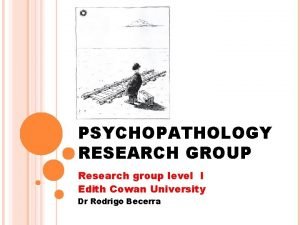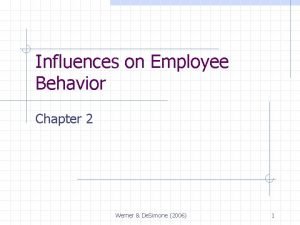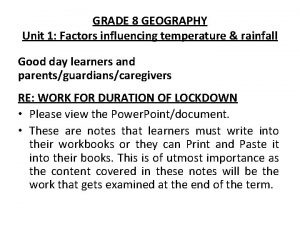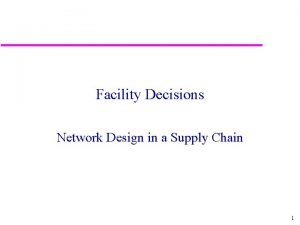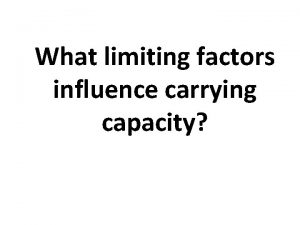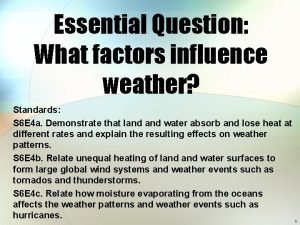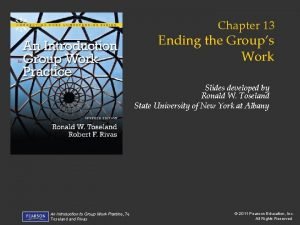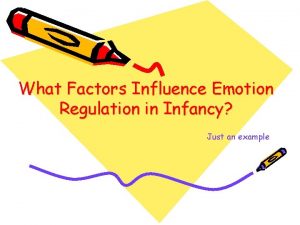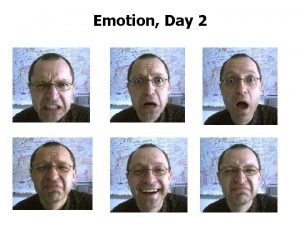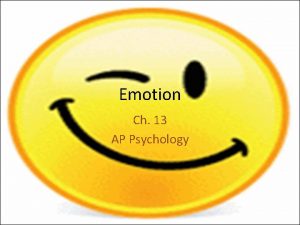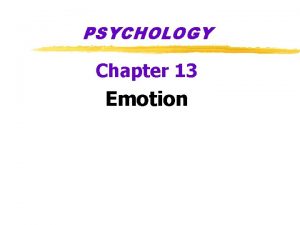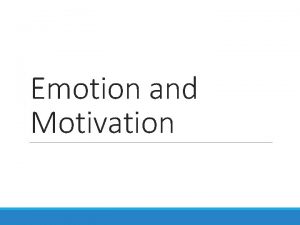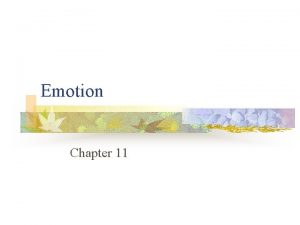What Factors Influence Emotion Regulation in Infancy Just











- Slides: 11

What Factors Influence Emotion Regulation in Infancy? Just an example

Abstract • The most common strategies are passive disengagement and physical regulation. • Highly reactive infants show deficiencies in emotion regulation development. • When caregivers are unavailable, infants use more regulation. • Father-infant avoidant attachment is associated with employment of distraction and self-soothing. • Physical stimulation can contribute to the negative emotional state of the infant.

What Is Emotion Regulation? • Definition – Intrinsic and extrinsic processes responsible for identifying, supervising, evaluating, and altering emotional reactions (Thompson, 1994). • Function – To manage arousal, control behaviors and reactions, and thereby define and adjust interactions to fit both individual and social demands. – If unable to master the task of emotion regulation, regulation “deleterious emotional arousal and the misleading identification and misdirection of emotions” (Kostuik & Fouts, 2002) can result, possibly leading to socially inappropriate behaviors and a limited ability to adapt to spontaneous experiences.

Strategies of Self Emotion Regulation In Infancy Regulation Strategy Mother Face-to-Face Mother Still-Face Mother Reengagement Stranger Face-to-Face Total Self-Soothing 5 11 5 4 25 Scanning 9 7 11 9 36 Passive Disengagement 15 18 20 18 71 Distraction 5 9 2 10 26 Physical 1 14 9 17 41 Total 35 59 47 58

Temperament • Anger and Frustration (Calkins, et al. , 2002) – Results • Easily frustrated infants used more physical regulation, scanning, and mother orienting, and less distraction. • In addition, they received lower scores on attention task exercises and were observed to have higher activity levels. – Conclusions • A “lack of focused attention coupled with a tendency to be very active and easily distressed may predispose the child to be unable to exert control over his or her behavior. ” behavior (Calkins, et al. , 2002)

Temperament • Effects of Excessive Crying (Stifter & Spinrad, 2002) – Results • Excessive criers exhibited significantly lower levels of self-regulation even after controlling for negative reactivity. • Higher levels of regulation were associated with less negativity. – Conclusions • Inattention that results from excessive crying inhibits infants’ ability to internalize regulation techniques, hence disturbing emotion regulation development. – Findings supported by Calkins, et al. (2002).

Infant-Caregiver Interactions • Parent Availability (Bridges, et al. , 1997) – Parent Active • Infants’ negative expression significantly decreased. • Infants’ levels of active engagement increased. – Parent Passive • More physical and self-soothing techniques observed. • Infants utilized more object focus. • Infants’ distress levels significantly higher in mother -passive than in father-passive situations. – Cross parent analysis reveal possible influence of type of parent-infant interaction (caregiver sensitivity (? )) experienced on emotion regulation.

Attachment Quality (Diener, et al. , 2002) • Infant-Father Attachment – Avoidant Attachment • Distraction and self-soothing most common techniques. – Secure Attachment • Infants exhibited fewer self-soothing behaviors. • Infant-Mother Attachment – No association between attachment quality and emotion regulation strategy found. – Similar to Bridges, et al. , implies a role of caregiver interaction type on regulation.

Physical Stimulation • Effects of Maternal Touch (Hernstein & Campos, 2001) – Negative Expression • Tension Increase – Infants demonstrated more negative emotional displays. » Less initiation of play. » Decrease duration of play. • Relaxation – Infants exhibited no differences from control infants in initiation or duration of play. – Positive Emotion • No major changes or differences in infants’ disposition for either condition.

Summary • The most common methods of emotion regulation in infants at 4 months are passive disengagement and physical strategies • Highly frustrated infants exhibit deficiencies in emotion regulation development. • Tension increase in physical stimulation via maternal touch increases negativity (regulates emotion) and hence emotion regulation in infants. • The level of emotion regulation necessary and the type of regulation utilized depends on parent availability in stressful situations. • The use of particular regulation techniques is associated with attachment quality in infant-father relationships.

References • • • Bridges, Lisa J. (1997). Infant Emotion Regulation with Mothers and Fathers. Infant Behavior and Development 20(1). 47 -57. Calkins, Susan D. , Dedmon, Susan E. , Gill, Kathryn L. , Lomax, Laura E. , and Johnson, Laura M. Frustration in Infancy: Implications for Emotion Regulation, Physiological Processes, and Temperament. Infancy, 3(2). 175 -197. Diener, Marissa L. , Mangelsdorf, Sarah C. , Mc. Hale, Jean L. , Frosch, Cynthia A. Infants’ Behavioral Strategies for Emotion Regulation With Fathers and Mothers: Associations With Emotional Expressions and Attachment Quality. Infancy 3(2). 153 -17. Hertenstein, Mathew J. , Campos, Joseph J. (2001). Emotion Regulation via Maternal Touch. Infancy 2(4). 549 -566. Stifter, Cynthia A. , Spinrad, Tracy L. (2002). The Effect of Excessive Crying on the Development of Emotion Regulation. Infancy 3(2). 133 -152. Kostiuk, Lynne M. , Fouts, Gregory T. (2002). Understanding of Emotion Regulation in Adolescent Females with Conduct Problems: A Qualitative Analysis. The Qualitative Report 7(1). www. nova. edu/ssss/QR/QR 7 -1/kostiuk. html
 Difficulty in emotion regulation scale
Difficulty in emotion regulation scale Did paris love juliet give evidence to support your answer
Did paris love juliet give evidence to support your answer Internal factors that influence employee behavior
Internal factors that influence employee behavior 5 factors that influence temperature and rainfall grade 8
5 factors that influence temperature and rainfall grade 8 Factors influencing network design decisions
Factors influencing network design decisions Factor affecting consensus
Factor affecting consensus Limiting resources biology
Limiting resources biology Factors that influence disease transmission
Factors that influence disease transmission What factors influence weather
What factors influence weather What are factors that influence communication?
What are factors that influence communication? Mid latitude meaning
Mid latitude meaning Factors that influence group endings do not include
Factors that influence group endings do not include
